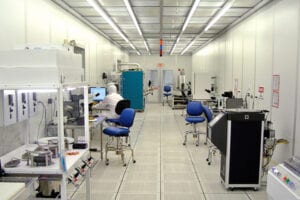Design Considerations for USP 797
USP 797 is a set of standards established by the United States Pharmacopeia for the safe preparation, handling, and administration of sterile medications in healthcare settings. These standards are designed to help prevent contamination and minimize the risk of infection to patients, healthcare workers, and others who may come into contact with sterile medications.

Here are some key design considerations for a facility that must comply with USP 797:
Air quality and ventilation: USP 797 requires that sterile compounding areas have a minimum of 30 air changes per hour (ACH) and that the air in these areas is filtered through high-efficiency particulate air (HEPA) filters. The facility must be designed to ensure that air is not recirculated from non-sterile areas, and that positive air pressure is maintained in the sterile compounding area.
Surface materials and finishes: The surfaces in sterile compounding areas must be smooth, durable, and easy to clean. Walls, floors, and ceilings must be finished with materials that are resistant to moisture and microbial growth, such as epoxy or vinyl flooring, and painted or tiled walls.
Workstations and equipment: The design of sterile compounding workstations and equipment must facilitate proper cleaning and disinfection, and minimize the risk of contamination. Workstations should be designed to ensure proper flow of materials and personnel, with separate areas for sterile and non-sterile components.
Storage and labeling: Proper storage and labeling of sterile medications is critical to preventing contamination and ensuring patient safety. Facilities must have designated storage areas for sterile medications, with appropriate temperature and humidity controls. All medications must be labeled with the appropriate information, including expiration dates, lot numbers, and other relevant details.
Training and education: Facilities must have ongoing training and education programs for personnel who prepare and handle sterile medications. These programs should cover a range of topics, including aseptic technique, proper gowning and hand hygiene, and the use of equipment and technology.
Overall, the design of a facility that must comply with USP 797 standards should prioritize safety, efficiency, and ease of use, while minimizing the risk of contamination and infection. Consultation with experts in pharmacy design and USP 797 compliance is recommended to ensure that all requirements are met.
